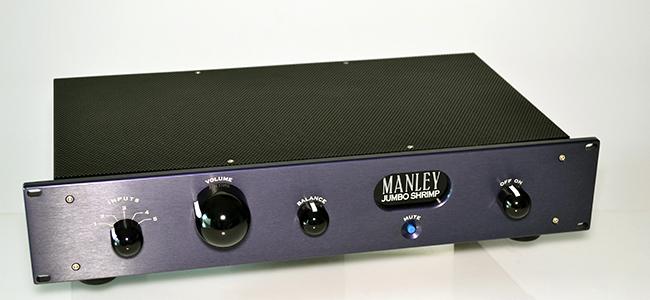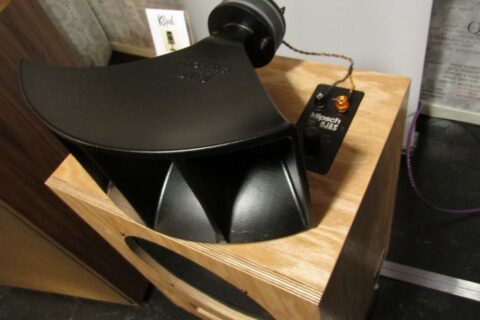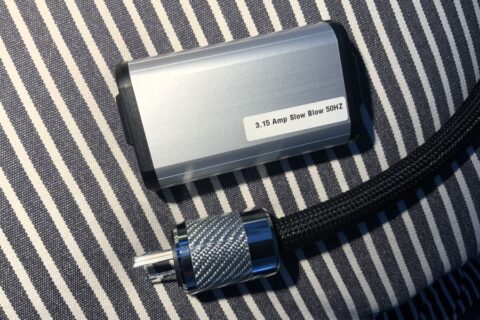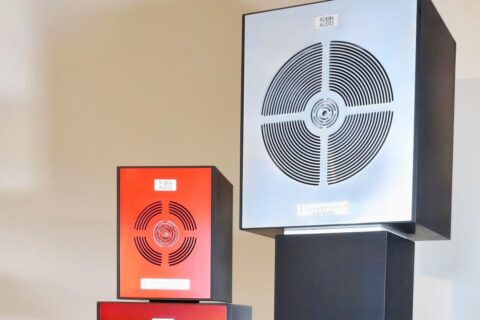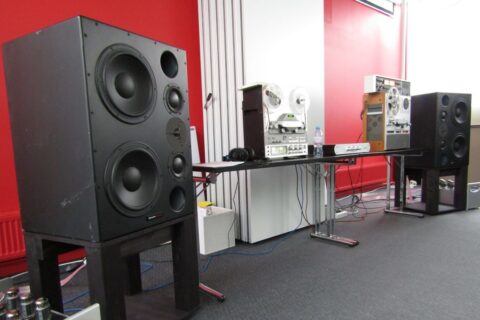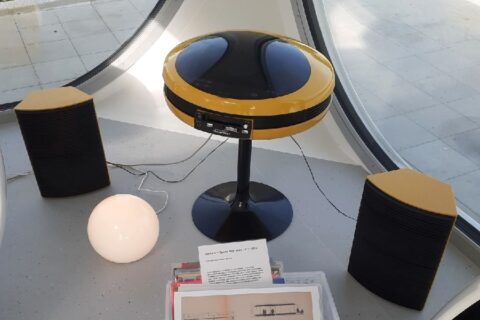Manley Labs is that leg of David Manley’s heresy that has continued to operate in the field of professional audio (eg. the famous VTL microphone preamps). But they do home audio as well, and as it should, all models are firmly based on vacuum tube technology. Shrimp is Manley Labs’ entry-level preamp from the early 2000, but the company still lists it in its product range. Jumbo Shrimp is basically Shrimp with a remote-controlled volume adjustment. The motorized control comes from the Alps Blue Velvet series (instead of Noble in Shrimp).
Jumbo Shrimp is said to feature a very short, non-inverting minimalist signal path. Tubes used include 2 x Electro-Harmonix 12AT7 at the input, 2 x GE USA 5670 as the driver/phase, and 2 x GE JAN NOS 7044 as output tubes. The specialty is the White Follower driver stage (instead of the more common Cathode Follower) using the 5670 dual triodes to drive all passive inter-stage circuits: volume, balance and output stages are controlled by the Follower regardless of control settings. The coupling caps are MIT/Multicap PPMF’s, including the two heavy 30μF caps at the output. No global negative feedback, the gain is 12dB. The input impedance is as high as 250 kilo-ohm, and the output impedance – thanks to the driver stage – as low as 50 ohms. S/N ratio is reported to be 95dB (A-weighted).
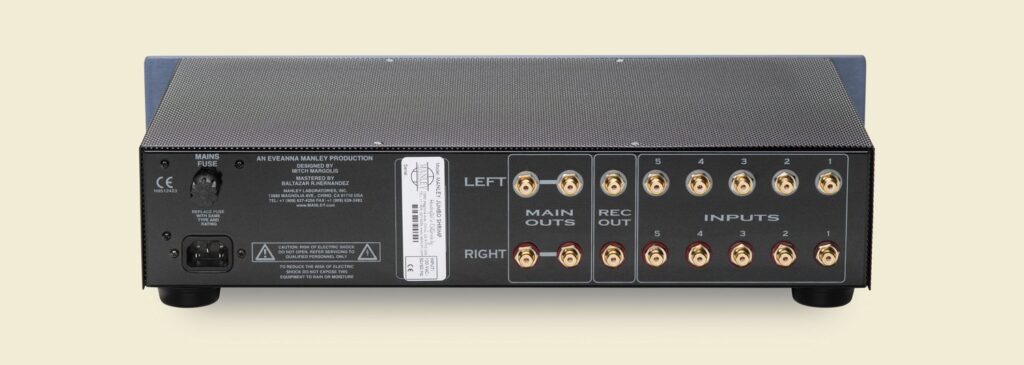
All components inside are on circuit boards, four motherboards and two smaller. Input connectors are soldered directly to the printed circuit board, and a long axel connects the front panel knob and the selector. Apart from the volume control and input selection the front panel has a balance control and mute/warming up knob. The top plate and the sides are made of thick steel mesh.
The preamp offers five unbalanced (RCA) inputs and two unbalanced (RCA) outputs. Outputs are connected in parallel. A very convenient feature, an unfortunately rare in preamps/integrated amps, is long enough distance between the input connectors: for once one does not need long thin fingers to insert the cables.

SOUND 1
To evaluate the nature of the “sound” that Jumbo Shrimp produces or adds to the whole, I first used both the power amp section of an Accuphase integrated and a DIY 6V6 power amp. Of the two, the effect was larger and immediately apparent with the Accuphase. As you would expect, the tone of the sound got a tad softer, gentler I might say. The Jumbo Shrimp cut out some straightforwardness and at the same time blew some spirit and liveliness to the sound. However, I’d say that the Jumbo Shrimp didn’t embellish things in the wrong way. The sound wasn’t as analytical (in a good sense) as it does in some transistor preamps but was still happily transparent, and what’s best: the surface of the sound had a nice sparkling texture in it.
The sound was fast, hot-tempered combined with good overall dynamics. No lingering here. The instruments were placed well in their positions in the sound stage, without pinpointing their coordinates. What I especially liked about the Jumbo Shrimp’s performance was that music didn’t sound too distant with it. Music was present to the ear without scruple. The only minus in the otherwise healthy sound was that from time to time the bass appeared to be over the top relative to other frequency bands.
So the conclusion of my first experiment was that if one likes the sort of sound described above, and has any eye for professional audio looks, Manley Jumbo Shrimp is a perfect fit. Old-style chicken cam switches would have made Jumbo Shrimp even sexier. This is a fine and competent tube preamp in many respects.
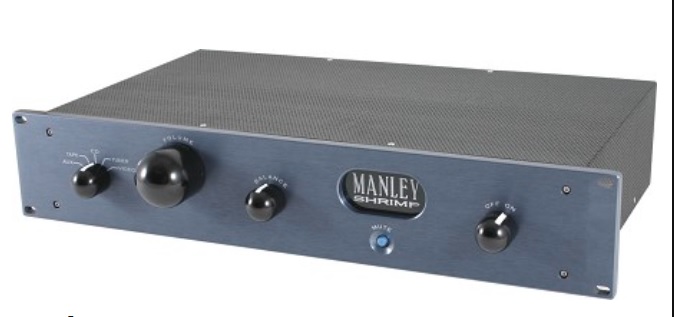
SOUND 2
Next I compared the Jumbo Shrimp to three high-end tube preamplifiers: McIntosh C220, EAR 834L, and RedWineAudio Isabella. All these preamps were more or less old creations, which only shows that if one has once managed to design a quality preamplifier, there’s no reason to reinvent it. The input tubes used vary from ECC83/12AX7 to E88CC. There are also differences between the circuits, but more variation in the power supplies, including the battery operation of the RWA Isabella. The features vary from McIntosh’s almost complete list to the essentials of the RWA and EAR.
As above, I first studied the sonic effect of the four preamplifiers on the overall sound by listening to the sample records and songs through the Accuphase integrated (Marantz turntable and DAC, Dunlavy Athenas as speakers), and then the same samples with the preamplifiers replacing the Accuphase preamplifier section and driving only the amps’ power amplifier part. The test situation was a juicy one in that it allowed studying the effect of a high-quality tube preamplifier adding – or not – its own tonal character, as we say, to the sound of a high-quality solid-state amplifier. Each preamplifier was allowed to warm up for 30-60 minutes before listening.
The samples included a Stravinsky string quartet, Ben Webster’s 57/58 recordings, Naim hi-fi compilation, a BBC Best Seller album of classical and non-classical music material, blues by Eric Bibb, and so on. My main focus was on listening to the clarity of the sound, its transparency, treble quality, separation of low-level details, sound imaging, and the general and dynamic ease of the sound.
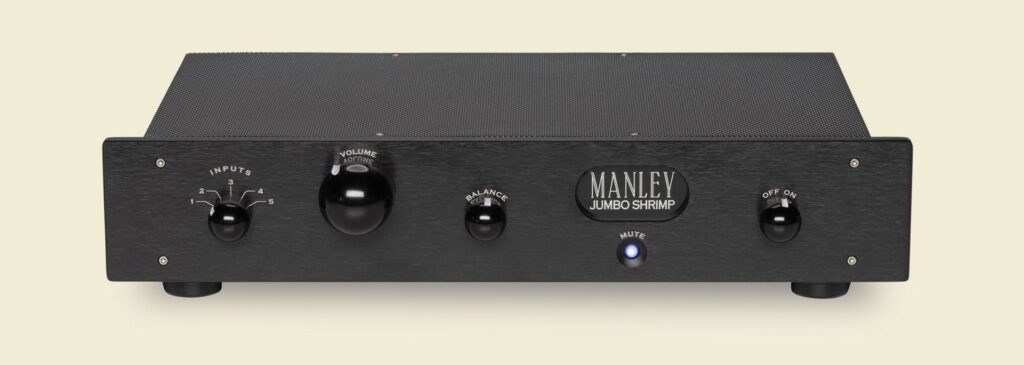
THE RESULT?
Each preamp appeared to add some value to the original sound: above all air, space – a structured sense of space -, but also timbre, although not necessarily always by softening the tone. Even in those cases where the difference was not that large, it was perceptible. The effect was perhaps most obvious with the Manley Jumbo Shrimp, the least with the RWA Isabella. With the Jumbo Shrimp, the sound was, as I could expect, most mid-rangy, most pearly, most tube-like. The McIntosh C220 and EAR 834L produced a lot of tube sound in the bottom register, and both breathed more life into the sound, yet in a way that even the fans of solid state amps would like it. RWA Isabella went even further in the direction of semiconductors in its cool subtlety and resolution.
The general conclusion from this second test could be crystallized as follows: Manley Jumbo Shrimp showed that falling in love with the sound of a tube preamplifier makes a lot of sense.
Manley Jumbo Shrimp, 3700e.
SPECIFICATIONS:
Gain: 11.8 dB%
Input impedance: 250kΩ
Otto’s sensitivity: 200mV at 1V output
Max. output voltage: 5V at 1.5% THD
Frequency Response: 10Hz – 80kHz-3dB, 20Hz – 20kHz-0.3dB
Noise:-83dB typical (20Hz – 20kHz max gain)
Noise:-95dB typical (A-weighted, 20Hz – 20kHz, max gain)
Signal to Noise Ratio (S / N ratio): 95dB typical (A-weighted, 20Hz – 20kHz, max gain)
Total Harmonic Distortion (THD): 0.02% at 1Vrms output
Output impedance: 50Ω
Power consumption: 55W
Weight: 6kg
www.manleylabs.com
Specifications:
Gain: 11.8 dB%
Input impedance: 250kΩ
Input sensitivity: 200mV at 1V output
Max. output voltage: 5V at 1.5% THD
Frequency Response: 10Hz – 80kHz-3dB, 20Hz – 20kHz-0.3dB
Noise:-83dB typical (20Hz – 20kHz max gain)
Noise:-95dB typical (A-weighted, 20Hz – 20kHz, max gain)
Signal to Noise Ratio (S / N ratio): 95dB typical (A-weighted, 20Hz – 20kHz, max gain)
Total Harmonic Distortion (THD): 0.02% at 1Vrms output
Output impedance: 50Ω
Power consumption: 55W
Weight: 6kg


